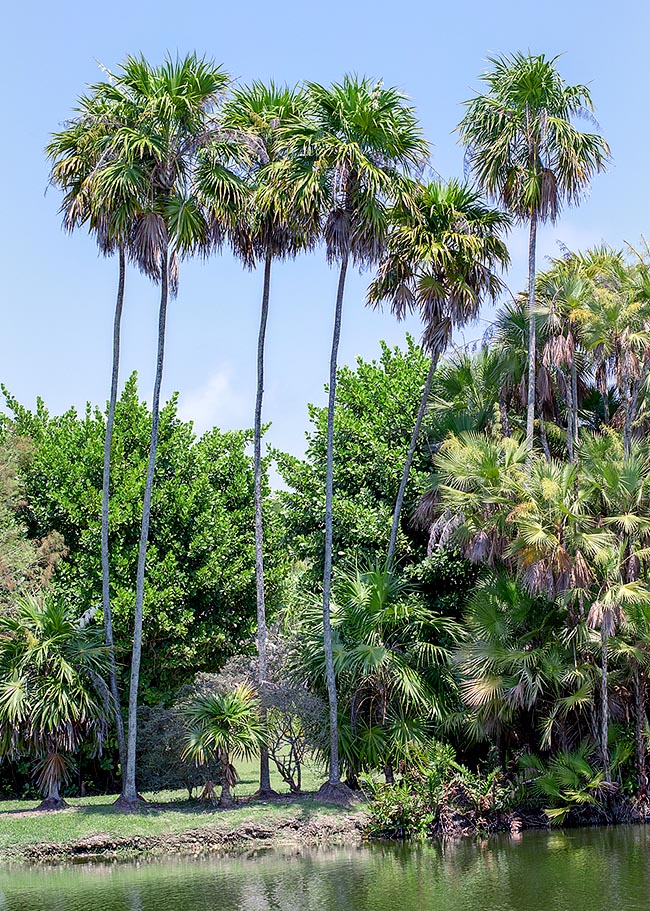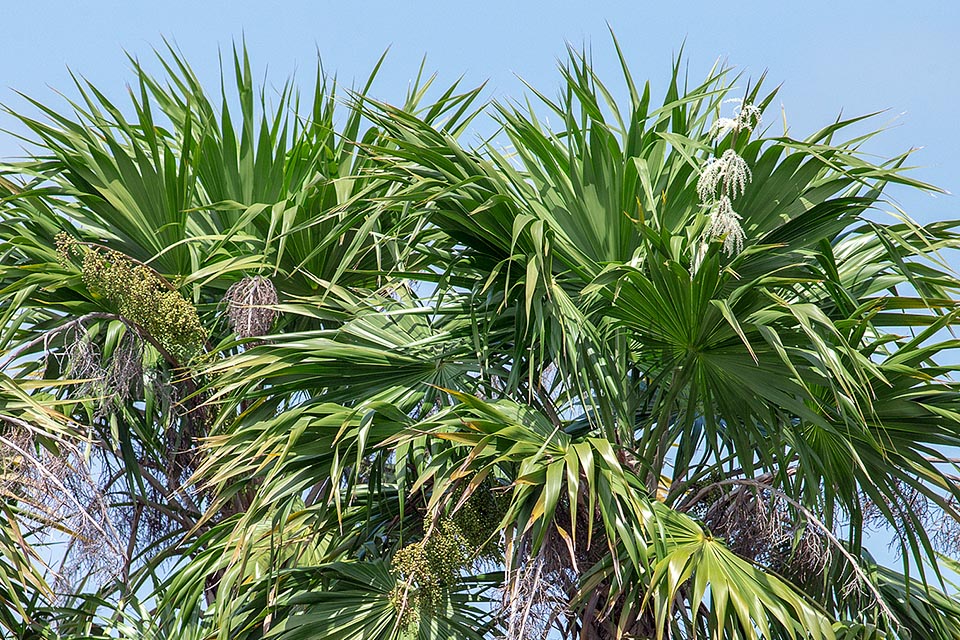Family : Arecaceae

Text © Pietro Puccio

English translation by Mario Beltramini
The species is native to Bahamas, Belize, Cayman Islands, Cuba, Honduras, Hispaniola, Mexico (Quintana Roo and Yucatan) and USA (Florida), where it grows along the coasts close to the sea on calcareous mainly sandy soils.
The name of the genus comes from the Greek “θρῖναξ” (thrinax) = “three-pronged pitchfork”, but also “shovel for sieving”, with possible reference to the palmate leaves; the name of the species is the Latin adjective “radiatus, a, um” = surrounded by rays, with reference to the segments of the leaf.
Common names: Florida thatch, Jamaican thatch, saltwater palmetto, sea thatch, silk-top thatch palm, thatch palm, top thatch palm (English); guano campeche, guano de costa (Cuba); thatch (Jamaica); latanier-la-mer (Haiti), chit, chi-it (Messico); guanillo (Dominican Republic).

Native to the mainly sandy coasts of the Bahamas, Belize, Cuba, Honduras, Hispaniola, Cahyman Islands, Mexico and Florida, the Thrinax radiata can reach the 10 m of height, with stems of 8-12 cm of diameter © Giuseppe Mazza
The Thrinax radiata Lodd. ex Schult. & Schult.f. (1830) is an unarmed monoecious species with solitary stem, rarely cespitous, erect, 2-10 m tall and of 8-12 cm of diameter, of greyish coulour with the annular scars of the fallen leaves, averagely spaced 5 cm, in the oldest part, covered by the residues of the foliar bases under the crown; it often appears with a mass of roots exposed at the base.
The leaves, on a 40-90 cm long petiole, are palmate, induplicate, almost circular and slightly wavy, of 1-1,6 m of diameter, of glossy dark green colour with yellow nervations above, paler and opaque below, divided in 50-60 linear-lanceolate segments having drooping acuminate apex, long in the central part, 0,8-1 m and 5-6 cm broad, united at the base per 1/3-1/2 of their length, excepting the two central often wholly united or almost up to the apex.
The foliar sheath, about 60 cm long, deeply fissured at the base in correspondence to the petiole, opens obliquely from the opposite side disintegrating in coarse fibres that wrap the stem.
Inflorescences between the leaves usually not exceeding their length, erect or slightly arcuate, curved when in fruit, of white color, initially enclosed by overlapping green bracts covered by tiny whitish scales. Ramifications of second order bearing hermaphroditic flowers, on a 1,5-2,5 mm long pedicel, fragrant, with cup-shaped perianth with 6 teeth, 5-10 stamens and monocarpellate gynaeceum.
Globose fruits, of 7-8 mm of diameter, white when ripe, containing only one globose seed, of 6-7 mm of diameter, of pale brown color.
It reproduces by seed, previously kept in water for 3 days, in particularly draining loam maintained humid at the temperature of 26-28 °C, with germination times starting from one month.
Slow growing species particularly attractive that due to its reduced dimensions finds an easy collocation in whatever type of garden, even if of limited extension, of remarkable landscaping effect in group or in rows.
Cultivable in the regions with tropical, subtropical and marginally warm temperate climates, where, when adult, may resist exceptional temperature values up to -2 °C, with possible damage to the leaves.
It requires full sun or at most a slight shade and perfectly draining soils, as it does not stand water stagnations, preferably calcareous, but adapts also to slightly acidic or neutral soils, resists the salty winds and short periods of drought, hence can be employed close to the sea and in desert-type gardens.

Almost circular leaves, 1-1,6 m broad, white scented inflorescences and globose edible fruits, of 7-8 mm, representing an important source of food for the avifauna © Giuseppe Mazza
Young plants can be cultivated for long time in pot for the decoration of open areas, where the climate allows so, and luminous inner spaces, utilizing loam rich of organic substance with addition of a 30% of coarse calcareous sand in order to improve the drainage, with lowest temperatures not under the 16 °C.
The fruits are edible and represent an important source of food for the avifauna, the stems are utilized in the constructions and the dry leaves, long lasting, as cover of rural houses and touristic structures and for fabricating hats, baskets, brooms, creels for lobsters and other craft objects.
Synonyms: Thrinax elegans Schult. & Schult.f. (1830); Thrinax gracilis Schult. & Schult.f. (1830); Thrinax pumilio Lodd. ex Schult. & Schult.f. (1830); Thrinax aurata Kunth (1841); Thrinax ferruginea Lodd. ex Mart. (1853); Thrinax maritima Lodd. ex Mart. (1853); Thrinax mexicana Lodd. ex Mart. (1853); Thrinax montana Lodd. ex Mart. (1853); Porothrinax pumilio H.Wendl. ex Griseb. (1866); Thrinax martii Griseb. (1866); Thrinax elegantissima Hook.f. (1884); Thrinax floridana Sarg. (1899); Coccothrinax radiata (Lodd. ex Schult. & Schult.f.) Sarg. (1901); Coccothrinax martii (Griseb.) Becc. (1908); Thrinax wendlandiana Becc. (1908).
